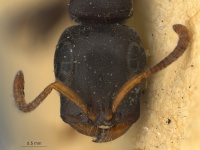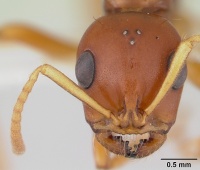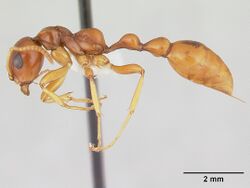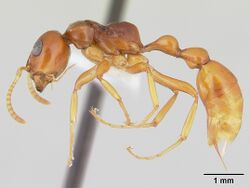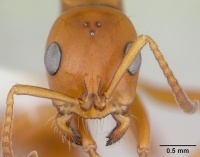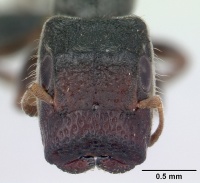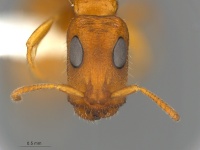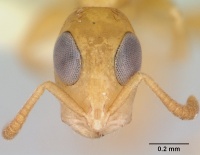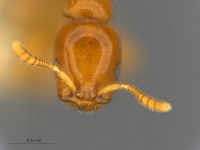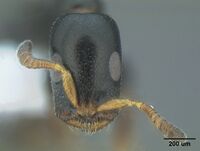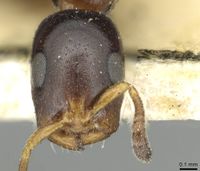Key to Afrotropical Tetraponera
This key to the workers of Tetraponera of the Afrotropical region is based on Ward (2022).
See also Key to Afrotropical Tetraponera species-groups.
Notes
This key is based predominantly on workers, but an attempt has been made to include identifying features of queens as well. Some caution should be exercised, however, because queen sample sizes are smaller than those of workers and the limits of intraspecific variation are less well understood. In addition, queens are unknown for six of the 38 species treated in the key (Tetraponera continua, Tetraponera dispar, Tetraponera elegans, Tetraponera insularis, Tetraponera pedana, Tetraponera setosa).
Measurements and Indices
- HW Maximum head width, including eyes.
- HL Head length, taken along midline, from the posterior margin of the head to the anterior extremity of the clypeus (concavities at either end do not reduce the measurement, i.e., in such cases measurement is taken from the midpoint of a line drawn across the anterior or posterior margin of the head capsule).
- EL Eye length, measured in same plane of view as HL.
- MFC Minimum distance between the margins of the frontal carinae, posterior to their fusion with, or approximation to, the antennal sclerites.
- SL Scape length, excluding radicle.
- FL Length of profemur, measured along its long axis in posterior view.
- FW Width of profemur, measured in same view as FL and at right angles to it.
- PL Length of petiole in lateral view from lateral flanges of the anterior peduncle to the posterior margin of petiole.
- PH Maximum height of petiole, measured in lateral view, orthogonal to PL, and excluding protruding teeth or lobes at anteroventral or posteroventral extremities of the petiole.
- DPW Maximum width of petiole, measured in dorsal view.
- PPW Maximum width of postpetiole, measured in dorsal view.
- LHT Length of metatibia, excluding proximomedial condyle (Ward 2001: fig. 5).
- CI Cephalic index: HW/HL.
- FCI Frontal carina index: MFC/HW.
- REL Relative eye length: EL/HL.
- REL2 Relative eye length, using HW: EL/HW.
- SI Scape index: SL/HW.
- SI2 Scape index, using HL: SL/HL.
- SI3 Scape index, using EL: SL/EL.
- FI Profemur index: FW/FL.
- PLI Petiole length index: PH/PL.
- PWI Petiole width index: DPW/PL
- CSC Cephalic setal count: number of standing hairs (i.e., those forming an angle of 45º or more with cuticular surface) visible on the posterior half of the head, as seen in lateral and posterior views.
- MSC Mesosomal setal count: number of standing hairs visible in profile (lateral view) on the mesosoma dorsum.
- HTC Metatibial setal count: number of standing hairs visible in outline on the outer (extensor) surface of the metatibia.
- MTC Mesotibial setal count: number of standing hairs visible in outline on the outer (extensor) surface of the mesotibia.
1
- Worker with well separated frontal carinae (MFC 0.39–0.71, FCI 0.21–0.35), three distinct ocelli, and a prominent, recurved anteroventral tooth on the petiole (Figs 33, 34); large species (worker HW 1.57–2.20, queen HW 2.30–2.50); west and central Africa (rufonigra-group) .....2
- Worker with more closely adjacent frontal carinae (MFC 0.06–0.24, FCI 0.08–0.25); worker with 0–2 ocelli and/or lacking prominent anteroventral petiolar tooth (usually both conditions apply); generally smaller species (worker HW 0.42–1.68, queen HW 0.47–1.61); widespread .....3
2
return to couplet .....1
- Frontal carinae widely separated, their minimum distance greater than one quarter of head width (worker FCI 0.28–0.35, queen FCI 0.36–0.37) (Fig. 34a); standing pilosity relatively common, conspicuous on the pronotum and propodeum (worker MSC 27–45, queen MSC 45–50) (Fig. 34b); mandibles smooth and shiny, with scattered fine punctures; Nigeria to DR Congo ..... Tetraponera latifrons
- Frontal carinae less widely separated, their minimum distance equal to about one quarter of head width or less (worker FCI 0.21–0.25, queen FCI 0.25–0.26) (Fig. 33a); standing pilosity less common, sparse on the pronotum and absent from the propodeum (worker MSC 1–7, queen MSC 10–14) (Fig. 33b); mandibles longitudinally rugulose and subopaque; Nigeria to DR Congo and western Uganda ..... Tetraponera aethiops
3
return to couplet .....1
- Worker mesonotum strongly transverse, 2–4× wider than long, with a rounded anterior margin and straight posterior margin, appearing more or less semicircular in dorsal view; pronotum with sharp lateral margination, extending in attenuated form to the lateral borders of the propodeum and petiole; head and mesosoma usually with dense punctulate-coriarious sculpture which imparts a matte appearance (punctulate with shiny interspaces in one Ugandan species); posteroventral margin of petiole with a median notch (natalensis group) .....4
- Worker mesonotum about as long as wide and appearing ovoid or sub-rectangular in dorsal view; pronotum, propodeum and petiole usually with soft-edged lateral margins, if sharply marginate (a few Madagascar species) then head and mesosoma shiny, not matte; posteroventral margin of petiole lacking median notch .....13
4
return to couplet .....3
- Medium-sized species (worker HW 1.27–1.54, queen unknown), blackish brown in color with strongly contrasting luteous legs, except for brown band on metafemur (Fig. 26b); standing pilosity very sparse (CSC 0–2, MSC 0–2), lacking on petiole; postpetiole and abdominal tergite 4 each with 0–2 standing hairs; endemic to Madagascar ..... Tetraponera insularis
- Variable in color and size but without the above color pattern; standing pilosity varying from sparse to abundant, but if lacking on petiole and very sparse on postpetiole and gaster, then body size smaller (worker HW 1.03–1.15, queen HW 1.22–1.26); occurring on African mainland .....5
5
return to couplet .....4
- Body-dark brownish-black and petiole as sharply marginate as the lateral margin of pronotum; standing pilosity sparse (worker CSC 0–2, worker MSC 0–4, queen CSC 2, queen MSC 0–6), the few erect setae relatively long, and distinct from the inconspicuous, short pubescence; worker: eyes large, about one half head length or more (REL 0.49–0.56) .....6
- Color variable but if dark brownish-black then petiole more soft-margined than pronotum, and pilosity common (worker CSC 8–60, worker MSC 20–120, queen CSC 7–16, queen MSC 12–75) and blending into a background of conspicuous suberect and subdecumbent pubescence; worker: eyes generally smaller, usually less than one half head length (REL 0.40–0.52) .....7
6
return to couplet .....5
- Smaller species (worker HW 1.03–1.15, queen HW 1.22–1.26, worker LHT 0.74–0.85, queen LHT 0.88–0.94); petiole, postpetiole, and abdominal tergite 4 with 0, 0, and 0–2 standing hairs, respectively; Mozambique, Tanzania, Kenya ..... Tetraponera andrei
- Larger species (worker HW 1.40–1.54, queen HW 1.45–1.49, worker LHT 1.08–1.21, queen LHT 1.14–1.22); petiole, postpetiole, and abdominal tergite 4 with 2–4, 2–6, and approximately 4–20 standing hairs, respectively; central Africa (Cameroon to Uganda) ..... Tetraponera anthracina
7
return to couplet .....5
- Dark brown to brownish-black, with lighter appendages; petiole with weak lateral margination, in dorsal view obovate, with rounded sides (Fig. 27b); worker petiole in profile with similar anterodorsal and posterodorsal slopes, or with less strongly inclined anterodorsal slope (Fig. 27b); standing pilosity conspicuous (worker CSC 8–60, worker MSC 21–120, worker HTC+MTC 0–50; queen CSC 7–16, queen MSC 12–75, queen HTC+MTC 2–42), often grading into an underlying suberect to decumbent pubescence .....8
- Color variable, usually yellow- to orange-brown, but if medium to dark brown then petiole with better defined lateral margination, in dorsal view narrowly obovate to subtrapezoidal, sides more or less straight, and diverging posteriorly (as in Fig. 25b); worker petiole variable in profile, but often with steep anterodorsal face and more shallowly inclined posterodorsal face (Fig. 28b); standing pilosity usually less common (worker CSC 2–18, worker MSC 3–28, worker HTC+MTC 0–10, queen CSC 2–8, queen MSC 8–24, queen HTC+MTC 0–4) and more distinct from underlying pubescence .....9
8
return to couplet .....7
- Head and mesosoma with scattered punctures, densest on anterior two thirds of head, the interspaces mostly smooth and shiny, or with weak reticulation; anterior clypeal margin lacking denticles, at most feebly crenulate; body very densely pilose (worker CSC ca. 40–60, worker MSC ca. 70–120; queen unknown); Uganda ..... Tetraponera setosa
- Head and mesosoma densely punctulate-coriarious, imparting a matte appearance to the integument (lacking shiny interspaces); anterior clypeal margin usually with several denticles, sometimes weakly defined; standing pilosity conspicuous but less abundant (worker CSC 8–34, worker MSC 21–100, queen CSC 7–16, queen MSC 12–75); widespread, west Africa to Ethiopia, south to Angola and Tanzania ..... Tetraponera mocquerysi
9
return to couplet .....7
- Scapes short (worker SI 0.45–0.49, queen SI 0.46–0.49) and profemur robust (worker FI 0.45–0.52, queen FI 0.49–0.53; worker FW/PL 0.49-0.56, queen FW/PL 0.44-0.51), such that worker FW/SL 0.68-0.77 and queen FW/SL 0.76-0.84; small species (worker HW 0.98–1.08, queen HW 1.10–1.16) .....10
- Scapes longer (worker SI 0.50–0.55, queen SI 0.49–0.54) and profemur more slender (worker FI 0.38–0.47, queen FI 0.43– 0.49; worker FW/PL 0.40-0.48, queen FW/PL 0.39-0.43) such that worker FW/SL 0.53-0.66 and queen FW/SL 0.62-0.73; size variable (worker HW 0.92-1.68, queen HW 1.00-1.61) .....11
10
return to couplet .....9
- Body light orange-brown, with variable infuscation around the ocelli and at the tip of the gaster (Fig. 25); petiole more robust, appearing broader in dorsal view (worker DPW/HW 0.45-0.49, queen DPW/HW 0.53-0.56); South Africa, Mozambique, Zimbabwe..... Tetraponera caffra
- Body predominantly medium brown, with lighter yellowish-brown appendages (Fig. 32) and sometimes lighter maculation on the gaster; petiole more slender, appearing slightly narrower in dorsal view (worker DPW/HW 0.39-0.44, queen DPW/HW 0.48-0.51); South Africa ..... Tetraponera kosi
11
return to couplet .....9
- Larger species (worker HW 1.38–1.68, queen HW 1.46–1.61; worker LHT 1.14–1.36, queen LHT 1.24–1.40), with smaller eyes relative to head width (worker REL2 0.43–0.49, queen REL2 0.46–0.49); Kenya to South Africa ..... Tetraponera schulthessi
- Smaller species (worker HW 0.92–1.29, queen HW 1.00–1.29; worker LHT 0.74–1.10, queen LHT 0.76–1.01), with larger eyes relative to head width (worker REL2 0.48–0.56, queen REL2 0.51–0.58) .....12
12
return to couplet .....11
- Worker mesonotum essentially indistinguishable from basal face of propodeum, not bounded posteriorly by a distinct transverse impression; worker petiole relatively high and short (PLI 0.67–0.80, PH/HL 0.43–0.50, PH/LHT 0.61–0.73) (Fig. 3); queen petiole short (PL/HW 0.84–0.87); coastal Kenya..... Tetraponera redacta
- Worker mesonotum usually distinguishable from basal face of propodeum, and separated from it by a transverse impression, albeit sometimes feeble; worker petiole height and length variable, but in east Africa (Tanzania, Kenya), close to the range of T. redacta, petiole tending to be longer and of lower height (PLI 0.64–0.70, PH/HL 0.39–0.45, PH/LHT 0.55–0.66) (Fig. 3); in same region queen petiole tending to be longer (PL/HW 0.85–0.93); Kenya, excluding coastal region, to South Africa, Angola, and eastern DR Congo..... Tetraponera natalensis
13
return to couplet .....3
- Appendages long and slender: scape length three-quarters or more of head width in workers (SI 0.72–0.90), slightly less in queens (SI 0.67–0.76), and length of metatibia subequal to, or slightly less than, that of head (worker LHT/HL 0.85–1.12, queen LHT/HL 0.83–0.98); worker with three distinct ocelli; endemic to Madagascar (grandidieri group) .....14
- Appendages shorter and more robust: scape length about two-thirds or less of head width (worker SI 0.40–0.70, queen SI 0.39–0.68) and length of metatibia distinctly less than that of head (worker LHT/HL 0.54–0.82, queen LHT/HL 0.48–0.69); worker with two ocelli or (more commonly) none; found in both Madagascar and mainland Africa .....22
14
return to couplet .....13
- Basal margin of mandible with a prominent tooth, in addition to four teeth on the masticatory margin (Ward 2009, fig. 1); an terior clypeal margin deflected ventrally; eastern and northern Madagascar..... Tetraponera merita
- Basal margin of mandible lacking tooth, masticatory margin with four teeth (Ward 2009, fig. 2); anterior clypeal margin directed forward, not deflected ventrally .....15
15
return to couplet .....14
- Petiole broad (worker PWI 0.61–0.65, worker DPW/HW 0.50–0.53; queen PWI ~0.66, queen DPW/HW ~0.55), subtriangular in dorsal view, and with a relatively short, thick anterior peduncle; workers larger, HW1.48–1.58, LHT 1.64–1.76; eastern Madagascar..... Tetraponera manangotra
- Petiole more slender (worker PWI 0.38–0.53, worker DPW/HW 0.30–0.46; queen PWI 0.42–0.65, queen DPW/HW 0.37– 0.50), obovate in dorsal view, and with a thin, elongate anterior peduncle; workers smaller, HW 0.95–1.44, LHT 1.05–1.59 .....16
16
return to couplet .....15
- Petiole very slender (worker PLI 0.38–0.43; Fig. 22b), petiole length equal to, or exceeding, head width (worker PL/HW 1.01–1.05); legs relatively long (worker LHT/HW 1.22–1.29); queen unknown but expected to have comparably long petiole and legs; eastern Madagascar ..... Tetraponera elegans
- Petiole less elongate (worker PLI 0.49–0.59, queen PLI 0.52–0.60), petiole length shorter than head width (worker PL/HW 0.70–0.85, queen PL/HW 0.77–0.88); legs shorter (worker LHT/HW 1.02–1.22, queen LHT/HW 1.00–1.13) .....17
17
return to couplet .....16
- Scape with conspicuous suberect and subdecumbent hairs; body tricolored: metasoma, appendages, and ventral margin of mesosoma orange, most of mesosoma reddish-brown, and head dark brownish black; endemic to Manongarivo Massif, Madagascar..... Tetraponera hirsuta
- Most hairs on scape appressed or decumbent, and generally inconspicuous, except those at the apex; body color variable but usually without preceding tricolor pattern; widespread .....18
18
return to couplet .....17
- Metanotal spiracle of worker not protruding above the profile of the mesosoma, as seen in lateral view (Ward 2009, fig. 5); head broad (worker CI 0.88–0.97, queen CI 0.87–0.89); head and mesosoma reddish-brown, metasoma and appendages paler; eastern Madagascar ..... Tetraponera inermis
- Metanotal spiracle of worker more or less protruding above the profile of the mesosoma, as seen in lateral view (Ward 2009, fig. 6); head usually more elongate (worker CI 0.77–0.90, queen CI 0.79–0.86); color variable .....19
19
return to couplet .....18
- Worker: dorsum of propodeum laterally compressed, the propodeum appearing subtriangular in posterior view; body and legs concolorous orange-brown; relatively large (worker HW 1.14–1.36, queen HW ~1.36); Ankarana massif, northern Madagascar..... Tetraponera hespera (in part)
- Worker: dorsum of propodeum more broadly rounded, the propodeum appearing domeshaped in posterior view; color and size variable, but if body and legs concolorous orange-brown then smaller in size (worker HW 1.01–1.12, queen HW 1.01–1.19) .....20
20
return to couplet .....19
- Legs uniformly light orange-brown, femora lacking conspicuous black banding; body usually bicolored, such that dark head contrasts with lighter orange-brown mesosoma and metasoma, less commonly unicolorous orange; eastern and northern Madagascar..... Tetraponera grandidieri
- Legs light orange-brown, with contrasting black bands on the distal portions of the mesofemur and metafemur; body concolorous or bicolored (in latter case both head and gaster are dark brownish-black) .....21
21
return to couplet .....20
- Body concolorous yellow brown or orange brown; northwestern Madagascar ..... Tetraponera hespera (in part)
- Body bicolored, head and gaster dark brown and contrasting with the lighter mesosoma; eastern Madagascar ..... Tetraponera variegata
22
return to couplet .....13
- Long axis of compound eye directed anteromedially (e.g., Ward 2006, fig. 4); upper half of mesosternum sparsely pubescent; workers dimorphic, with a discrete soldier subcaste (ambigua-group) .....23
- Long axis of compound eye directed anteriorly or anterolaterally; mesosternum densely pubescent almost throughout; workers monomorphic (allaborans-group) .....26
23
return to couplet .....22
- Smaller species (worker HW 0.51–0.71, queen HW 0.50–0.69) with elongate head (worker CI 0.66–0.79, queen CI 0.52–0.67); masticatory margin of mandible with four teeth; African mainland and Arabian Peninsula .....24
- Larger species (worker HW 0.80–0.92, queen HW 1.03) with broader head (worker CI 0.89–0.92, queen CI 0.74); masticatory margin of mandible with six teeth; endemic to Madagascar ..... Tetraponera phragmotica
24
return to couplet .....23
- Standing pilosity common on mesosoma dorsum (worker MSC 12–44, queen MSC 20–56); larger species (worker HW 0.61– 0.71, queen HW 0.62–0.69), with disproportionately smaller eyes (worker REL2 0.54–0.60, queen REL2 0.59–0.64); Senegal to Arabian Peninsula, south to South Africa ..... Tetraponera ambigua
- Standing pilosity virtually absent from mesosoma dorsum in worker except for one pair of long setae on pronotum (worker MSC 2–3), and relatively sparse in queen (queen MSC 8–13); smaller species (worker HW 0.51–0.59, queen HW 0.50–0.60), with larger eyes (worker REL2 0.63–0.72, queen REL2 0.66–0.73) .....25
25
return to couplet .....24
- Worker: standing pilosity common on posterior half of head, conspicuous in profile (CSC 12–22); queen: posterolateral corner of head with a linear patch of raised, roughened cuticle, flanking the ocellar triangle; petiole short and robust (worker PLI 0.54–0.61, worker PL/HL 0.46–0.50, queen PLI 0.59–0.64); east Africa (Somalia to Mozambique) ..... Tetraponera parops
- Worker: standing pilosity sparse on posterior half of head (CSC 2–4); queen: posterolateral corner of head without a linear patch of raised, roughened cuticle; petiole usually more elongate (worker PLI 0.47–0.56, worker PL/HL 0.50–0.54, queen PLI 0.46–0.55); west and central Africa, east to Kenya ..... Tetraponera ophthalmica
26
return to couplet .....22
- Occurring on Madagascar and Comoros Islands ..... Malagasy allaborans-group (treated no further here)
- Occurring on African mainland .....27
27
return to couplet .....26
- Worker frontal carinae more closely contiguous (worker FCI 0.08–0.14), minimum distance between them less than one quarter of scape length (worker MFC/SL 0.13–0.22); petiole elongate and slender (worker PLI 0.50–0.61, queen PLI 0.49–0.59; worker PWI 0.38–0.48, queen PWI 0.40–0.51); masticatory margin of mandible with 3 teeth; scape generally longer (worker SI 0.56–0.67; queen SI2 0.38–0.47) (Figs 4, 7–10) .....28
- Worker frontal carinae more widely separated (worker FCI 0.13–0.24), minimum distance between them varying from one quarter to one half of scape length (worker MFC/SL 0.26–0.54); petiole relatively short and broad (worker PLI 0.72–1.21, queen PLI 0.73–1.29; worker PWI 0.57–0.97, queen PWI 0.59–1.22); masticatory margin of mandible with 4-5 teeth; scape generally shorter (worker SI 0.41–0.58, queen SI2 0.28–0.37) (Figs 5, 6, 11–16) .....32
28
return to couplet .....27
- Known only from queen caste and suspected of being a workerless social parasite; conspicuous standing pilosity on mesosoma (MSC 16) and petiole (Fig. 9b); small in size (HW 0.55, LHT 0.43); South Africa ..... Tetraponera exactor
- Workers and queens; standing pilosity sparse on mesosoma (worker MSC 0–2, queen MSC 0–6) and absent from petiole (Figs 4b, 7b, 8b, 10b); size variable, generally larger .....29
29
return to couplet .....29
- Small (worker HL 0.66–0.67, worker LHT 0.43–0.44) with broad head (worker CI 0.77–0.78) and relatively large eyes (worker REL 0.35) (Fig. 7a); queen unknown but expected to be similar (HL ~0.75, LHT ~0.48, CI ~0.75, REL ~0.35); light orangebrown; Republic of Congo ..... Tetraponera dispar
- Larger (worker HL 0.74–0.99, worker LHT 0.48–0.64; queen HL 0.88–1.12, queen LHT 0.54–0.65) with more elongate head (worker CI 0.70–0.76, queen CI 0.67–0.72) and smaller eyes (worker REL 0.28–0.32, queen REL 0.27–0.31) (Figs 4a, 8a, 10a); color varying from yellowish-orange to dark brown; occurring in southern Africa (South Africa, Eswatini, Zimbabwe) .....30
30
return to couplet .....29
- Worker: scape shorter (SI 0.56–0.62) and petiole shorter and broader (PWI 0.46–0.48, PL/HW 0.72–0.77); medium-brown with variably lighter mesonotum and appendages (Fig. 10); alate/dealate queen unknown, an apparent ergatoid with SI 0.56 and PL/HW 0.83; South Africa ..... Tetraponera furtiva
- Scape longer (worker SI 0.61–0.68; queen SI 0.57–0.66) and petiole more slender (worker PWI 0.38–0.46, worker PL/HW 0.79–0.94; queen PL/HW 0.92–1.03); uniformly yellowish-orange or dark brown .....31
31
return to couplet .....30
- Yellowish-orange (Fig. 8); scape longer (worker SI 0.64–0.68; queen SI2 0.43–0.47) (Fig. 2); South Africa, Eswatini, Zimbabwe ..... Tetraponera emeryi
- Dark brown (Fig. 4); scape tending to be shorter (worker SI 0.61–0.64; queen SI2 0.38–0.42) (Fig. 2); South Africa ..... Tetraponera clypeata
32
return to couplet .....27
- Eyes very small (worker REL2 <0.32, queen REL2 ~0.32) and scape very short (worker SI <0.45, queen SI ~0.40); petiole broad (worker PWI ~0.90, queen PWI ~1.00), and furnished with a large, subrectangular subpetiolar process, rounded anteroventrally and posteroventrally (Fig. 16b); orange-brown to reddish-brown .....33
- Eyes larger (worker REL2 0.33–0.48, queen REL2 0.35–0.53) and scape longer (worker SI 0.47–0.58, queen SI 0.45–0.60); petiole less broad (worker PWI 0.57–0.86, queen PWI 0.59–0.81), lacking a large subrectangular ventral process; brown to brownish-black .....34
33
return to couplet .....32
- Queen (based on original description): 6.3 mm long, with elongate head (CI ~0.60) and tridentate median clypeal lobe; worker unknown but expected to be moderately large (HW ~0.75) with a dentate clypeal lobe and elongate head (CI ~0.70); see discussion in text; Cameroon ..... Tetraponera mayri
- Queen: 4–5 mm long, with broader head (CI 0.71–0.78) and convex, edentate median clypeal lobe; worker: small (HW 0.58– 0.66) with moderately broad head (CI 0.76–0.84); median clypeal lobe convex, lacking teeth (Fig. 16a); obligate inhabitant of Vitex; Ghana to DR Congo..... Tetraponera tessmanni
34
return to couplet .....32
- Worker with standing pilosity as follows: one to several pairs of setae on the frontal carinae, and usually one pair on the vertex and pronotum (CSC 0–2, MSC 0–2); worker propodeum and petiole laterally rounded, their dorsal surfaces appearing broadly convex in posterior view; queen of moderate size (HW 0.75–0.87, LHT 0.60–0.68) and with frontal carinae relatively close, the minimum distance between them less than one fifth of head width (queen FCI 0.15–0.18); Mozambique, Namibia, South Africa, Zimbabwe ..... Tetraponera liengmei (Forel)
- Worker with standing pilosity sparser, lacking on frontal carinae, vertex, and pronotum (CSC 0, MSC 0); worker propodeum and petiole laterally submarginate, and their dorsal surfaces appearing almost flat in posterior view; queen variable in size, usually smaller, but if approaching or exceeding the above size range, then frontal carinae more widely separated, the minimum distance between them more than one fifth of head width (queen FCI >0.20) .....35
35
return to couplet .....34
- Anterior margin of clypeus with only a single pair of stout setae, directed anteroventrally (Fig. 15a); very small (worker HW 0.42–0.53, queen HW 0.47; worker LHT 0.30–0.38, queen LHT 0.37); Ghana to Kenya, south to Zimbabwe ..... Tetraponera pumila
- Anterior margin of clypeus with multiple setae, one pair directed anteriorly, and 4–6 setae directed anteroventrally; generally larger (worker HW 0.41–0.83, queen HW 0.47–0.94; worker LHT 0.36–0.72, queen LHT 0.40–0.90) .....36
36
return to couplet .....35
- Head relatively broad (worker CI 0.78–0.86, queen CI 0.64–0.68) (Figs 13a, 14a); frontal carinae more widely separated relative to eye length, the minimum distance between them equal to, or exceeding, one half of eye length (worker MFC/EL 0.50–0.65, queen MFC/EL 0.55–0.64) .....37
- Head more elongate (worker CI 0.61–0.73, queen CI 0.50–0.64) (Figs 5a, 6a, 11a); frontal carinae less widely separated relative to eye length, the minimum distance between them less than one half of eye length (worker MFC/EL 0.30–0.48, queen MFC/EL 0.37–0.44) .....38
37
return to couplet .....36
- Upper third of head and most of mesosoma dorsum smooth and shiny, with scattered punctures (Fig. 13); legs shorter, worker LHT 0.37–0.47, worker LHT/HW 0.64–0.73 (queen unknown); Central African Republic, Uganda, Kenya ..... Tetraponera pedana
- Dorsum of head and mesosoma predominantly reticulate-coriarious and opaque (Fig. 14); legs longer, worker LHT 0.50–0.72, queen LHT 0.79–0.90; worker LHT/HW 0.77–0.88, queen LHT/HW 0.94–1.01); east Africa (Ethiopia to Tanzania) ..... Tetraponera penzigi (Mayr)
38
return to couplet .....36
- Upper third of head smooth and shiny, with scattered punctures; frontal carinae more closely adjacent (worker FCI 0.12–0.15, queen FCI 0.17) (Fig. 6a); legs shorter (worker LHT/HW 0.73–0.78, queen LHT/HW 0.86); central Africa ..... Tetraponera cortina
- Head sublucid, with scattered punctures on coriarious background sculpture; frontal carinae more widely separated separated (worker FCI 0.16–0.19, queen FCI 0.22–0.23) (Figs 5a, 11a); legs longer (worker LHT/HW 0.87–1.00, queen LHT/HW 0.99–1.01) .....39
39
return to couplet .....38
- Petiole short, high and broad (worker PLI 0.82–0.93, queen PLI 0.73–0.78; worker PH/HW 0.56–0.67, queen PH/HW 0.72– 0.78; worker DPW/HW 0.43–0.53, queen DPW/HW 0.61–0.64) (Fig. 11b); postpetiole relatively broad (worker PPW/HW 0.56–0.64, queen PPW/HW 0.77–0.81) (Fig. 1); Eritrea to Zimbabwe ..... Tetraponera gerdae (Stitz)
- Petiole slightly more elongate, lower, and narrower (worker PLI 0.72–0.82, PH/HW 0.53–0.55, DPW/HW 0.40–0.43) (Fig. 5b); postpetiole less broad (worker PPW/HW 0.50–0.52) (Fig. 1); queen unknown but expected to have more slender petiole (PLI ~0.70, PH/HW ~0.70, DPW/HW ~0.60) and postpetiole (PPW/HW ~0.75); west Africa to Ethiopia ..... Tetraponera continua (Forel)




